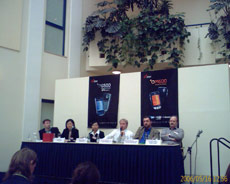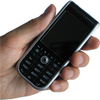|
|
Review of GSM/UMTS-smartphone HTC MTeoR (Breeze)
Standard kit:
- Smartphone
- Charger
- Wire stereo-headset
- Data cable
- Carrying case
- CD with the software
- User guide
A year ago the Taiwanese company HTC (High Tech Computer) turned to be the only strong maker of devices powered by Windows Mobile for Smartphone. Even today it is still the manufacturer ¹1 for this platform. However the list of competitors already contains such vendors as Samsung, Motorola and don’t forget about the aggressive newbie from China TFW (Tech Faith Wireless or simply TechFaith). As for the strong competing products, there are analogs of the BlackBerry (Moto Q, Samsung i320), but it’s just the beginning. Very soon HTC will face tough competition on its field, and we aren’t sure who will be the winner.
In summer 2006 HTC introduced its own trademark, which nominally substitutes Qtek. Till that moment smartphones of the company had been known under the variety of operator and vendor trademarks. Here is not the full list of them: Orange, O2, Vodafone, Qtek, I-mate, Dopod. Despite that the company is aimed at “great integration”, leave the single trademark on the market, the devices will still come out in near future under different names being equal inside. The model with the codename Breeze (the name of the platform or as they call it inside the company – the playform) is the first smartphone released under HTC trademark. The device has the index HTC MTeoR, we can trace the influence of Motorola RAZR in the name. Besides the Breeze has other names – Dopod 595, I-mate SP JAS, Orange SPV C700. Different modifications might have different additional software, a front camera for video calls (HTC MTeoR lacks it, while Dopod 595 has it). Untypical for HTC smartphones, there aren’t either different shell modifications or color solutions – only one design version and one shell color.
The main task facing HTC during the creation of the device was the support of 3G/UMTS networks. One of the key tasks for the near future is to add the support of 3G to all future products. All efforts were applied in this direction. In fact, HTC MTeoR is the world first 3G Windows Mobile smartphone (don’t mix up with Pocket PC).
HTC Breeze platform belongs to the 5th generation of company’s smartphones. Let’s revise the generation history of the company.

First generation. Codename – HTC Canary. Basically it was the company’s first experience, an attempt to manifest own potential. At the commercial launch there were almost no Windows-smartphones on the market and the product wasn’t heartily welcomed -it was pretty cumbersome and lacked Bluetooth and camera modules onboard, it couldn’t make to the market’s top. There were not many people who believed in Microsoft’s OS success in the middle of 2003.
Second generation. Codename – HTC Voyager. Upgraded and amplified platform offered slightly modified design and at the same time new version of operating system, significantly improved display, new camera module and support of Bluetooth (essential things for an up-to-date smartphone). The model was greatly appreciated and the number of ODM-partners (operators) grew in an avalanche-like way.
Third generation. Codename – HTC Typhoon. It was a breakthrough. Battery life got appreciably boosted, dimensions were equaled to those of up-to-date business-handsets, so the device turned to be the smallest smartphone. Moreover, the new platform offered new version of OS and miniSD cards slot. All in all it was one the best smartphones in 2004, with which only Nokia 6630 could compete; and if we take into account such parameters as battery life and dimensions, the Typhoon was beyond competition. It was also the first time when the company started offering various design concepts for one platform – HTC Feeler, HTC Sonata, HTC Amadeus.
Fourth generation. Codename – HTC Hurricane/Tornado. The most fetching improvement here was implementation of a QVGA-display. Before the release of Nokia N90 it had been holding the title of the smartphones’ best display. Another moment in the assessment is a 1.3-megapixel camera (older models featured VGA). HTC Tornado, which we treat as the fourth generation’s offspring as well, was the fist smartphone with Wi-Fi wireless connectivity, it was powered by the recent Windows Mobile 5.0 for Smartphone OS. At the release the HTC Tornado products (for example, Qtek 8300) outpaced Nokia similar models in functionality, smaller dimensions, the price was at the same level. We don’t mention direct rivals, as there was simply none.
The company makes the decision to release products based on the 4th generation platform in different form-factors, thus extending the lineup. So we saw HTC Star Trek (Qtek 8500) clamshell, HTC Excalibur (HTC S620) QWERTY-smartphone, HTC Oxygen (HTC S310) low-end candy bar. However the development of 3G networks dictated the need for 3G-devices, and Nokia completed the 3G switch in smartphones long ago and relatively painless.
Fifth generation. Codename– HTC Breeze. The key innovation is the support of 3G/UMTS networks, it required the shift from the TI integrated solution to the pair of Samsung CPU and Qualcomm cell module. Minor improvements include hot swap for storage cards, tilt-wheel, slimmer shell. On the other hand the smartphone features heavier weight, larger dimensions and the lack of built-in Wi-Fi module. I’d say the device has only one key change – the support of 3G. Let’s resume the review and see what HTC MTeoR is in fact.

Design, ergonomics
Compared to the previous models the new smartphone is somewhat wider and taller, but slimmer (112.4x49x49.8 mm against 109x47x19 mm for HTC Tornado). However the device doesn’t look or feel slim in contemporary meaning. The weigh built up some weight to 120 g because of the partially metallic shell (battery cover, screen edging and buttons). We can’t call the device the smallest on the market. Its design is pretentiously strict, it lacks outstanding features, we can trace designer’s efforts not to jump out of the limits for the business phone. This is a classical candy bar phone, there is hardly a more precise definition. The device is targeted at men’s audience. As for the assembly quality, there can’t be any complaints, this is a typical HTC product. Shell metal feels the very metal, there aren’t any backlashes.
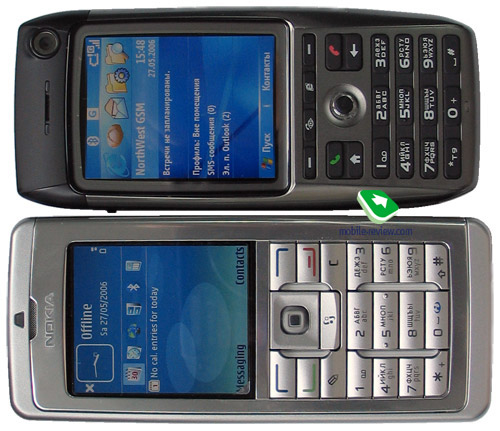
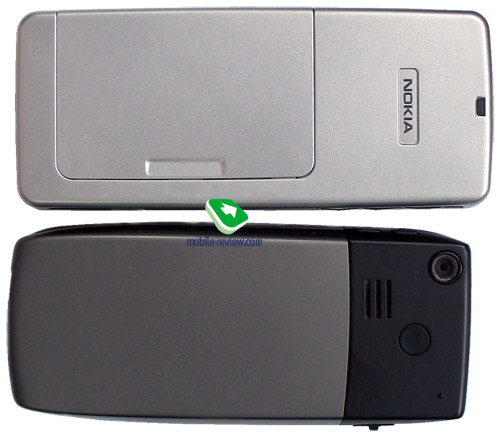

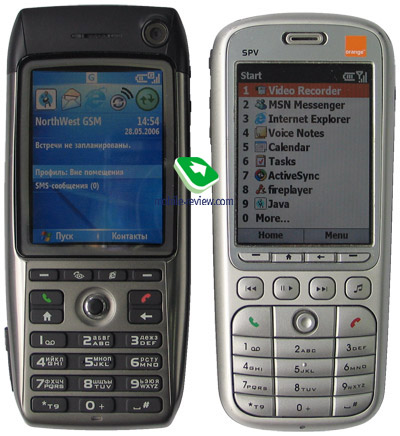


Right under the screen we see 4 slim buttons – two soft buttons, e-mail and Internet Explorer buttons. On the face of it, you might find them uncomfortable to work with. That’s not true, one can get accustomed to them very quickly. Below them are Talk and End, Home (resume the startup screen) and Back (returns to the previous page or deletes the last symbol, depending on the situation) buttons. Its five-direction pad is comfortable and doesn’t rouse any complaints.

As for the digital keyboard, I can’t say it’s either a failure or very comfortable. You just won’t think about the ergonomics of buttons, dimensions and feedback. The light sensor will switch on blue backlight in the dark. It’s rather pale with letters hardly distinguishable, you have to peer into it.


Above the screen we find a speaker with 2 LEDs at sides. There is a power button at the top (a short push launches the list of profiles). At the right side are a voice control button, a camera button and a full-functional IrDA port. The side buttons feature firm keystroke, they slightly stick out, so, there is a chance to press them accidentally, when the device isn’t blocked. You’d better not forget to block it when carrying in pants’ pockets to avoid involuntary calls.

At the left side is a 3-positional scrolling wheel convenient to browse menu, Internet-pages, lists. It helps adjusting sound level during talks. The ergonomics got improved with this wheel. We have no reprimands to it, everything works as it should. Lower we see an expansion slot for microSD cards, protected with the rubber gag, there is the possibility of hot swap. Currently the highest capacity available for microSD cards is 2 GB, the wholesale price tag equals $74 (1 GB - $25). Almost all new HTC products involve microSD format.



The camera lens and the battery compartment are hidden at the back panel. At the bottom is an HTC Ext. USB connector (charging, sync cable, headsets). Alas, there isn’t any adapter for the headset, so you’ll have to use the stereo headset from the kit to listen to the music, the quality is far from the ideal.




Battery life
The device carries a Li-Ion 1190 mAh battery, more capacious against the predecessor. It is claimed to work for 5 hours in talk mode and 8 days standby. Our tests in conditions of the Moscow GSM-network MTS reveled that HTC MTeoR was good for 2.5 days with 15 minutes of talks, 20 send SMS and 1 hours of other functions. In conditions of Megafon network the smartphone hardly lasted for 1.5 days with 40 minutes of talks per day, intensive GPRS work (about an hour per day using the Internet and e-mail), half an hour of other functions. At the same time HTC Tornado on the same load worked at least 2 days. If you read specialized forums, you’ll find out that battery life in 3G-networks is the weak point. There is some unofficial info that Orange operator canceled the C700 because it failed battery life test, the Breeze didn’t perform well enough to meet operator’s lowest standards for offline work. Well, battery life in the smartphone turned to be the main disappointment, this is a step backwards for HTC. However if you used to charging the device once a day, that won’t be a problem for you.

The battery life problems are rooted in the cell module solely. HTC MTeoR performed well with the phone part of in our standard tests. Under the maximum load (fullscreen video playback from the storage card) the smartphone worked for 7 hours 30 minutes, the continuous music playback from the storage card (screen off, “flight” mode) drained out the battery in 22 hours. In the e-book mode with auto scrolling HTC MTeoR lasted for 13 hours 30 minutes.
Under the battery is a non-standard SIM-card mount. The manual provides detailed comments how to insert and eject it. To remove the card you have to pull the tag, which is secure enough not to be torn off. This is unprecedented for HTC to apply this kind of SIM-card mount.

Display
The smartphone is equipped with the screen like in previous models – TFT 320x240 pixels (QVGA). This is no longer the main advantage – there are several Nokia models with higher resolution, longer diagonal, richer colors. Currently this resolution is standard for Windows Mobile for Smartphone devices.
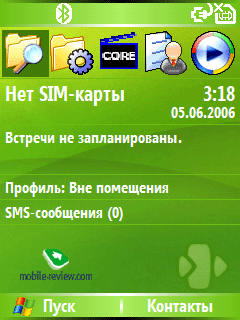
Physically the screen can display 262K colors (this figure is in the specifications), but because of OS limitations it can display no more than 65K colors. The image can be seen almost at any angle, the picture can loses colors, however the text remains readable. More than a year ago the screen of HTC Tornado was the best among analogs, now that of HTC MTeoR is quite typical and yields to top Nokia products.
Wireless modules
Unlike HTC Tornado the MTeoR doesn’t have an integrated Wi-Fi module – another step backwards. The company did so to add the support of Wi-Fi in future products to reveal functional improvements.
The smartphone features Bluetooth 2.0 without EDR (enhanced data transfer speed). A Windows Mobile integrated stack is applied to operate Bluetooth, all restrictions effective.
Bluetooth profiles:
- Headset – works with wireless headset.
- Object transfer. It’s possible to transfer contacts, calendar events to other devices and receive them, except for tasks and audio notes.
- It’s possible to send and receive any file. File Transfer profile isn’t completely implemented, you can transfer one file at once.
- There is the support of COM-connection –ActiveSync via Bluetooth and connection with Bluetooth GPS-receiver run smoothly.
- Dial-UP – you can access the Internet from PC or notebook via Bluetooth.
- A2DP – transfer of stereo sound to Bluetooth-headphones, control the playback from the headphones.
- HID – connection of the Bluetooth-keyboard.
- BT Remote SIM Access.

These are all Bluetooth profiles. All weak points result from restrictions of integrated Microsoft drivers – there are almost no settings, no support of FTP-profile. Gradually the situation with Microsoft drives is improving, but not greatly.
Qualcomm MSM6275 chip supports HSDPA (high speed data transfer) for 3G networks, but this connectivity option is idle in the smartphone with the only reason to add HSDPA support in future products.
Camera
Unfortunately, there haven’t been any camera improvements in HTC smartphones for a long time. The camera is outdated – 1.3-megapixel (1280x1024 pixels – the highest resolution), the lack of flash, mirror, auto focus and macro mode. Currently this can hardly be called an average quality. If you care much about camera quality, HTC MTeoR won’t be your choice. Let’s have a look at the photos shot with this camera.

Software
The smartphone is powered by Windows Mobile 5.0 for Smartphone operating system. You can read the review on its standard features on our site. Here we’ll talk about exterior programs.
Review Windows Mobile 5.0 for Smartphone>>>

ClearVue Office. The OS version for smartphones doesn’t contain applications to view office documents. The task is solved with exterior programs. ClearVue Office lets you viewing Word, Excel, PowerPoint and PDF documents.
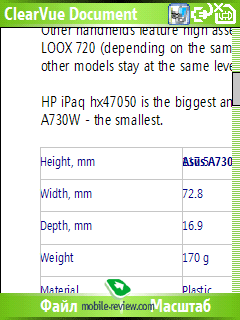 
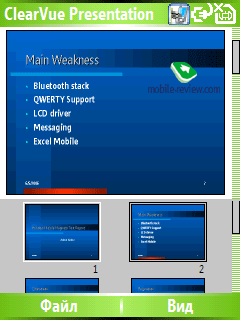
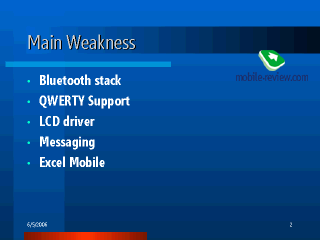

MIDlet Manager. As we see from the name this utility launches Java-programs. Not many of available programs are working. There isn’t the support of Java 3D, version of MIDP is 2.0.

MMS composes multimedia messages, everything is intuitively clear.
File Manager is a comfortable file browser. It can unpack ZIP-archives, show system info (charge % left, free memory size).
Modem Link. This utility allows using the smartphone as the modem. The following connection types are possible: USB, IrDA-port.
Task Manager displays launched programs. You can shut done idle programs to free the memory. Besides it’s possible to watch the system info.
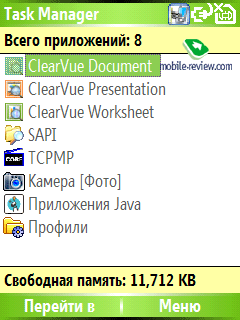
Specifications
The smartphone is built on a new Samsung processor running at the maximum rate of 300 MHz. Clock rate can be changed automatically depending on current load. The available flash-memory for storing all user’s data and settings makes up 73.07 MB. As for the available RAM, it equals 53.60 MB (usually only 30 MB of it is free).
Let’s see the results of JBenchmark 2 tests. We see great superiority of HTC MTeoR over other products, but we won’t make any conclusions on this ground, as the results depend greatly on Java implementation in a particular device.
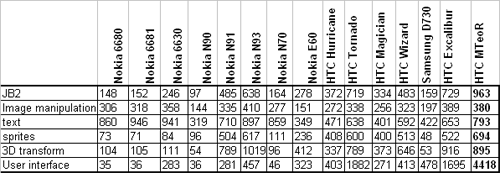
We tested video with The Core Pocket Media Player program (ex BetaPlayer) and got the following results. The performance close to 100% implies that the movie ran smoothly without dropped frames, however some active scenes might fail.
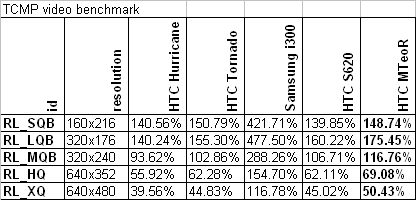
Thus, you need to convert movies before watching them. Naturally, the device features excess productivity to cope with other tasks. Samsung 300 MHz processor encourages productivity growth to 14% during video playback, to 34% for Java against TI 200 MHz processor. Subjectively, you won’t feel the difference in interface speed.
Impression
As for the reception and sound quality, there aren’t any problems, that’s typical for up-to-date handsets. The device has average call sound and silent alert. Developers hit the bull’s eye giving the codename to the platform. This isn’t a tornado or hurricane, but a breeze.
Let’s get our thoughts back to the previous year, the release of HTC Tornado. At that moment the model looked more functional, more compact compared to any counterparts from Nokia (QVGA screen, Wi-Fi – unprecedented for smartphones). Given the similar price, the HTC product whetted more appetite. Even today HTC Tornado versions enjoy good demand.

What do we have for an update, in the 5th generation platform? This is a UMTS and one more time a UMTS. Well, there appeared storage card hot swap, comfortable scrolling wheel improving ergonomics, but these are minor changes. All other specs remained the same (camera, for example) or turned worse (dimensions, weight, battery life problems, the lack of Wi-Fi). The product is offered at a price at least 100 USD higher than Nokia’s devices. The reader will be right to argue with the comparison – smartphones by Nokia and HTC work on different platforms. It’s partly true, but if we take into account functionalities, the comparison is well-backed up. This might be the reason why HTC sells much more Pocket PC devices than WM for Smartphone ones.

However if you mean to get the Windows Mobile smartphone supporting 3G, you have almost no other choice. There arise two questions. Firstly, why there disappeared a camera for video calls in HTC MTeoR, while UMTS is its key innovation? Secondly, why is HSDPA switched off, while Qualcomm MSM6275 chipset supports this standard? That’s definitely not for haste, the main works on the Breeze project were completed in December 2005. The company meant to add the support in future products, to show the progress and development.
Compared to HTC Typhoon and HTC Tornado HTC MTeoR looks pale and doesn’t hit imagination with specs and new functions. Probably we see the effect of the 3G shift and in future the company will offer breakthrough products, like the Typhoon and Tornado.
Related links:
Description:
- Type: Windows Mobile-smartphone;
- Form-factor: candy bar;
- Materials used: metal/ plastic;
- Position in the line-up: above HTC Tornado (Qtek 8310/8310);
- Operating system: Windows Mobile 5.0 for Smartphone, AKU 2.3;
- CPU: Samsung 2442M 300 MHz;
- RAM: 53.75 MB available (30 MB usually free);
- ROM: 128 MB (73.07 MB available to store data, install programs);
- Connectivity: microSD (hot swap), IrDA (SIR), Bluetooth 2.0 not supporting EDR, USB for charging/ synchronization;
- UMTS 2100, GSM 900/1800/1900, GPRS, EDGE (Qualcomm MSM6275 chip);
- Display: TFT 2.2” 240x320 pixels, 65K colors;
- Camera: CMOS 1.3 Mpix without flash, video capture;
- Highlights: scrolling wheel at the left side;
- Battery: removable Li-Ion 1190 mAh. Battery life claimed:
- Talk time – 5 hours;
- Standby time – 8 days;
- Dimensions: 112.4x49x14.8 mm;
- Weight: 120 g.
Anton Kotov (anton.kotov@mobile-review.com)
Translated by Anja Rytchkova (anja.rytchkova@mobile-review.com)
Published — 05 February 2007
Have something to add?! Write us... eldar@mobile-review.com
|
News:
[ 31-07 16:21 ]Sir Jony Ive: Apple Isn't In It For The Money
[ 31-07 13:34 ]Video: Nokia Designer Interviews
[ 31-07 13:10 ]RIM To Layoff 3,000 More Employees
[ 30-07 20:59 ]Video: iPhone 5 Housing Shown Off
[ 30-07 19:12 ]Android Fortunes Decline In U.S.
[ 25-07 16:18 ]Why Apple Is Suing Samsung?
[ 25-07 15:53 ]A Few Choice Quotes About Apple ... By Samsung
[ 23-07 20:25 ]Russian iOS Hacker Calls It A Day
[ 23-07 17:40 ]Video: It's Still Not Out, But Galaxy Note 10.1 Gets An Ad
[ 19-07 19:10 ]Another Loss For Nokia: $1 Billion Down In Q2
[ 19-07 17:22 ]British Judge Orders Apple To Run Ads Saying Samsung Did Not Copy Them
[ 19-07 16:57 ]iPhone 5 To Feature Nano-SIM Cards
[ 18-07 14:20 ]What The iPad Could Have Looked Like ...
[ 18-07 13:25 ]App Store Hack Is Still Going Strong Despite Apple's Best Efforts
[ 13-07 12:34 ]Infographic: The (Hypothetical) Sale Of RIM
[ 13-07 11:10 ]Video: iPhone Hacker Makes In-App Purchases Free
[ 12-07 19:50 ]iPhone 5 Images Leak Again
[ 12-07 17:51 ]Android Takes 50%+ Of U.S. And Europe
[ 11-07 16:02 ]Apple Involved In 60% Of Patent Suits
[ 11-07 13:14 ]Video: Kindle Fire Gets A Jelly Bean
Subscribe
|


























